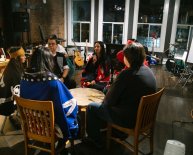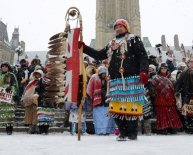
Aboriginal spirituality beliefs
Our spirituality is a oneness and an interconnectedness with all that lives and breathes, even with all that does not live or breathe.—Mudrooroo, Aboriginal writer [1]
Aboriginal spirituality, Mudrooroo continues, “is a feeling of oneness, of belonging”, a connectedness with “deep innermost feelings”. Everything else is secondary.
Aboriginal spirituality involves the land
The earth, their country, is “impregnated with the power of the Ancestor Spirits” which Aboriginal people draw upon [2].
They experience a connection to their land that is unknown to white people. A key feature of Aboriginal spirituality is to look after the land, an obligation which has been passed down as law for thousands of years.
“Spirituality is about tapping into the still places I go to when I’m on country and I feel like I’m part of all the things around me, ” explains Senimelia Kingsburra, from the far north Queensland Yarrabah community [2].
Quandamooka woman Evelyn Parkin also values the silence which connects her with the land. “The spiritual contact with mother earth holds me in my place, ” she says [8].
A powerful explanation of the spiritual connection of Indigenous people to the land can be found in a publication of the now abolished ATSIC [3].
We don't own the land, the land owns us. The land is my mother, my mother is the land. Land is the starting point to where it all began. It's like picking up a piece of dirt and saying this is where I started and this is where I'll go. The land is our food, our culture, our spirit and identity.—S. Knight [3]
Aboriginal author and Yorta Yorta woman Hyllus Maris (1934-86) expressed this connectedness with the land beautifully in her poem Spiritual Song of the Aborigine [4].
Spiritual Song of the Aborigine
I am a child of the Dreamtime People Part of this Land, like the gnarled gumtree I am the river, softly singing Chanting our songs on my way to the sea My spirit is the dust-devils Mirages, that dance on the plain I'm the snow, the wind and the falling rain I'm part of the rocks and the red desert earth Red as the blood that flows in my veins I am eagle, crow and snake that glides Thorough the rain-forest that clings to the mountainside I awakened here when the earth was new There was emu, wombat, kangaroo No other man of a different hue I am this land And this land is me I am Australia.
Poem by Hyllus Maris.
Aboriginal spirituality is the belief that all objects are living and share the same soul or spirit that Aboriginals share.—Eddie Kneebone, Aboriginal Reconciliation campaigner and painter [5]
This is a very fundamental statement about Aboriginal spirituality. It implies that besides animals and plants even rocks have a soul.
An Aboriginal person’s soul or spirit is believed to “continue on after our physical form has passed through death”, explains Eddie Kneebone [5]. After the death of an Aboriginal person their spirit returns to the Dreamtime from where it will return through birth as a human, an animal, a plant or a rock. The shape is not important because each form shares the same soul or spirit from the Dreamtime.
There is not one Aboriginal spirituality
One might believe that Aboriginal spirituality is similar across Australia but this is not the case.
“Aboriginal spirituality is so incredibly diverse, ” says Aboriginal director Warwick Thornton, “there are 50 languages left, 30 of them critical but all of them with their own culture, their own spirituality, their own creation stories, their own everything.” [9].
What is not Aboriginal spirituality?
Many texts and books use ‘Aboriginal religion’ when addressing Aboriginal spirituality. But these two terms should not be confused:
Spiritual “relates to people’s deepest thoughts and beliefs, rather than to their bodies and physical surroundings” [6].
Religious is “something that is about or connected with religion”, i.e. “the belief in a god or gods and the activities that are connected with this belief, such as prayer or worship in a church or temple” [6].
Hence spirituality is the foundation of religion, the deeper layer of any religious practice and expression.
Some little children come in and say 'but God made the world'. And I say, 'Yes, according to the Bible, yes, God did; but according to my spiritual beliefs my rainbow serpent made these things', so we don't have any arguments over that either; they understand: religion is their way, spiritualism is our way. They understand.

















